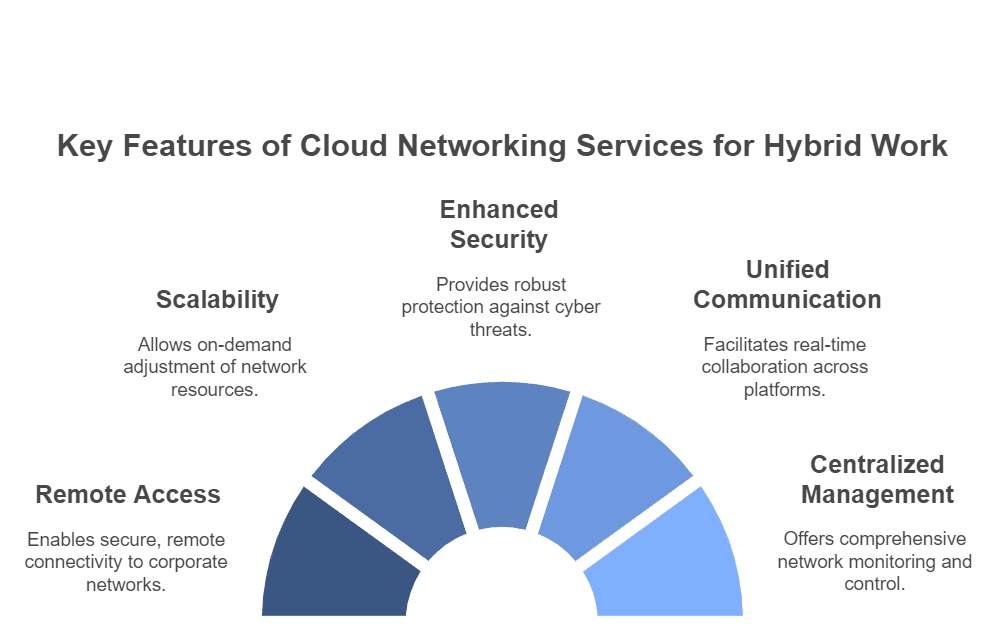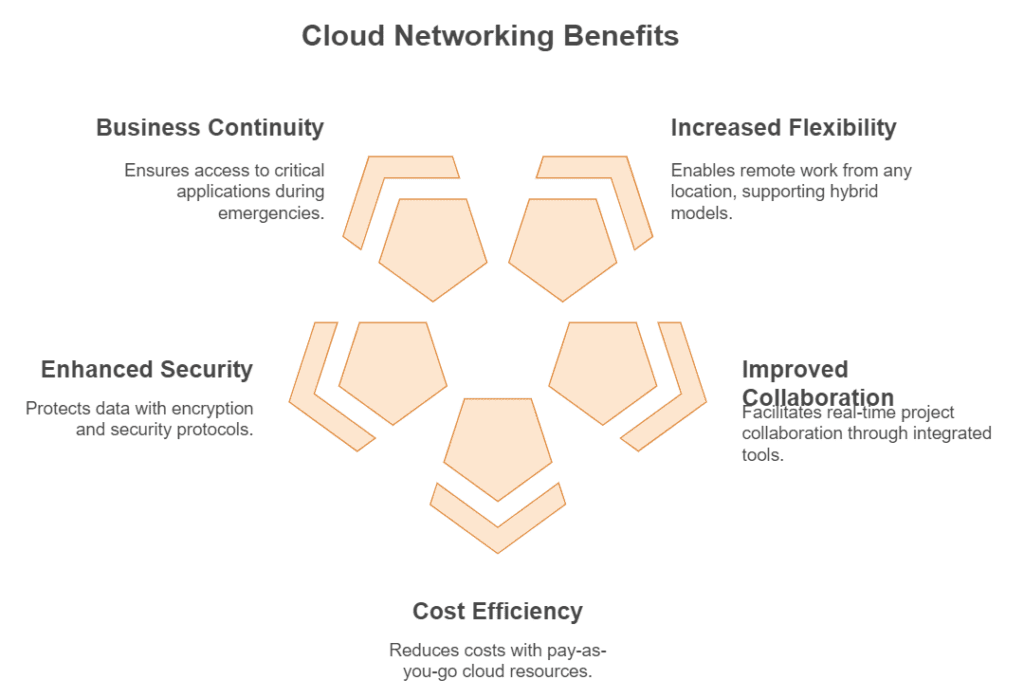How Cloud Networking Services Support Hybrid Work Environments
The rise of hybrid work environments has transformed how businesses operate, enabling employees to work both remotely and in-office. In this model, ensuring seamless connectivity, security, and collaboration is crucial. Cloud networking services play a pivotal role in supporting hybrid work by providing scalable, flexible, and secure infrastructure for organizations. In this blog, we’ll explore how cloud networking services empower businesses to thrive in a hybrid work environment, discussing their benefits, features, and importance in modern workplaces.
Understanding Hybrid Work Environments
A hybrid work environment blends remote work with on-site operations, giving employees the freedom to work from different locations. The COVID-19 pandemic accelerated this transition, and many businesses have since adopted hybrid models for better flexibility, employee satisfaction, and productivity.
However, hybrid work presents challenges, especially regarding network management, security, and collaboration. That’s where cloud networking services come into play. These services ensure that employees, whether working remotely or on-site, can access the necessary resources and communicate securely without interruptions.
Key Features of Cloud Networking Services for Hybrid Work

Cloud networking services provide a range of features to support hybrid work environments. Let’s look at some key functionalities:
1. Remote Access and Connectivity
Cloud networking solutions, such as Virtual Private Networks (VPNs) and SD-WANs (Software-Defined Wide Area Networks), enable secure access to corporate networks from any location. Employees can connect remotely to internal systems without compromising security or performance.
2. Scalability
Cloud networking services offer on-demand scalability, allowing businesses to quickly adjust their network resources based on changing demands. Whether your team grows or your workload fluctuates, cloud networks scale seamlessly to accommodate new users or higher traffic.
3. Enhanced Security
Security is a top priority for hybrid work environments. Cloud networking services provide end-to-end encryption, zero-trust network architectures, and multi-factor authentication (MFA) to protect sensitive data from cyber threats.
4. Unified Communication and Collaboration
Cloud networking facilitates seamless communication by integrating with Unified Communications as a Service (UCaaS) platforms like Microsoft Teams, Zoom, and Slack. This ensures that employees, regardless of location, can collaborate effectively in real-time.
5. Centralized Network Management
With cloud networking, IT teams can monitor, manage, and troubleshoot the entire network from a centralized platform. This provides full visibility into network performance, enabling swift issue resolution and reduced downtime.
Benefits of Cloud Networking in Hybrid Work Environments

1. Increased Flexibility
Cloud networking allows employees to work from virtually any location, making it easier to implement hybrid models. It eliminates the need for physical connections, allowing workers to remain productive whether they are in the office, at home, or traveling.
2. Improved Collaboration
With cloud-based networking tools, employees can access shared resources and collaborate on projects in real-time. The use of integrated tools like file-sharing, video conferencing, and instant messaging fosters efficient communication among team members regardless of their physical location.
3. Cost Efficiency
Cloud networking services reduce costs by eliminating the need for extensive on-site hardware, maintenance, and network infrastructure. Instead of investing in costly physical equipment, businesses can use cloud resources based on a pay-as-you-go model, significantly reducing operational expenses.
4. Enhanced Security
Hybrid work introduces new security challenges, as employees may use unsecured home networks to access company resources. Cloud networking addresses these concerns by providing encrypted data transfers, firewalls, and security protocols that ensure data remains safe even when accessed remotely.
5. Business Continuity
Cloud networking supports business continuity by enabling remote access to critical applications and data during emergencies, such as natural disasters or pandemics. Employees can continue their work without interruption, ensuring that operations remain stable in unpredictable circumstances.
How Cloud Networking Supports Different Aspects of Hybrid Work
| Hybrid Work Challenge | Cloud Networking Solution | Benefits |
| Secure Remote Access | VPNs, SD-WANs | Employees can safely access corporate resources from anywhere. |
| Scalable Network Infrastructure | Cloud-based networking tools like VPCs | Network infrastructure scales up or down based on demand. |
| Data Security | End-to-end encryption, multi-factor authentication (MFA) | Data is protected from cyber threats even on remote networks. |
| Real-time Collaboration | UCaaS platforms, file-sharing services | Teams can collaborate effectively, regardless of location. |
| Centralized IT Management | Centralized cloud management platforms | IT teams can monitor and manage the network with ease. |
Cloud Networking Services and Hybrid Work: Real-World Use Cases
1. Remote Access to Sensitive Data
A company operating in the financial services industry implemented cloud networking solutions to enable employees to securely access sensitive financial data while working remotely. By using VPNs and end-to-end encryption, they ensured that their clients’ financial information remained protected even when accessed from home networks.
2. Global Team Collaboration
A tech startup with a distributed team across different continents adopted cloud networking services to streamline global communication. With tools like Microsoft Teams and Google Drive, the team could collaborate on development projects in real-time, significantly improving their workflow.
3. Healthcare and Compliance
A healthcare organization shifted to hybrid work using cloud networking tools that complied with HIPAA regulations. Through secure cloud networking services, healthcare professionals could access patient data remotely without violating privacy laws.
Choosing the Right Cloud Networking Service for Hybrid Work
When selecting cloud networking services for your hybrid work environment, consider the following factors:
1. Security Features
Security should be a top priority. Look for services that provide multi-layered security, including encryption, firewalls, MFA, and data loss prevention (DLP).
2. Scalability
Ensure the cloud networking solution can scale with your business. Whether your workforce grows or your traffic surges, the service should adjust seamlessly to accommodate your changing needs.
3. Integration with Collaboration Tools
Choose services that integrate well with popular collaboration platforms such as Microsoft Teams, Zoom, and Slack. These integrations will make it easier for your teams to communicate and collaborate effectively in a hybrid setup.
4. Cost-Effectiveness
Review the pricing models of cloud networking services. Opt for pay-as-you-go plans that allow you to only pay for the resources you need, minimizing unnecessary expenses.
5. Centralized Management
Look for platforms that offer centralized network management to give your IT team full control over the network, ensuring optimal performance and quick issue resolution.
Future Trends: The Role of Cloud Networking in Hybrid Work
As hybrid work models become the norm, cloud networking services will continue to evolve. Emerging technologies such as 5G, AI-driven network management, and cloud-native security solutions will further enhance cloud networking capabilities, making it even easier for businesses to manage hybrid work environments.
Additionally, we can expect to see more focus on edge computing as businesses look to bring data processing closer to the source, improving performance and reducing latency for remote workers.
Conclusion
Cloud networking services are essential in supporting the hybrid work environment by providing flexibility, scalability, and security. They empower businesses to overcome the challenges of remote work while ensuring smooth collaboration, seamless access, and cost-effective operations. By leveraging these tools, organizations can create resilient, efficient hybrid work models that cater to both employee preferences and business needs.
Investing in the right cloud networking solution is not only crucial for today’s hybrid work demands but also sets the stage for long-term success as the workplace continues to evolve.


